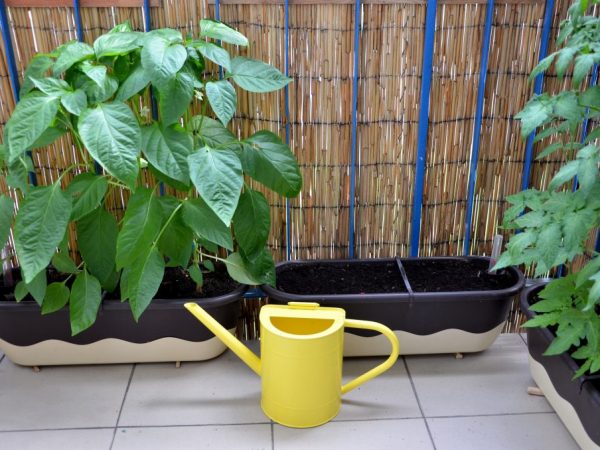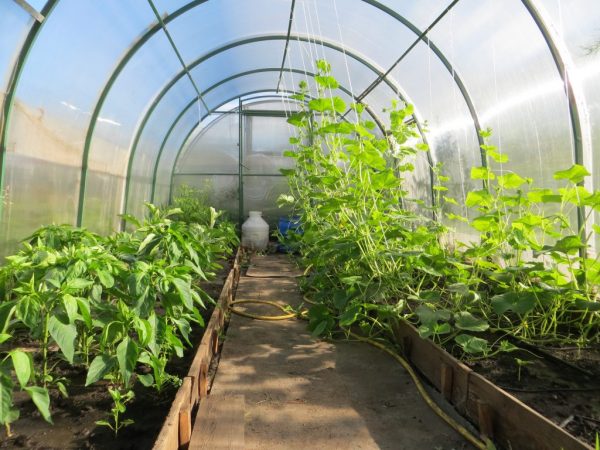Neighbors for pepper
When growing vegetables, you need to know which crops can grow close to each other, and which ones are best not to plant nearby. If unfavorable crops are planted next to pepper, the plant may not bear fruit at all. Consider which neighbors for pepper are useful and which are capable of causing harm.

Neighbors for pepper
Favorable neighborhood
All vegetables that surround pepper play an important role in its formation, development and even safety: they promote the process of photosynthesis, improve soil conditions and repel insects.
Eggplant
The neighborhood of bitter peppers with eggplant is useful and very convenient. These vegetable crops interact well. They are unpretentious in care, for their joint cultivation, the same climatic conditions and irrigation regime are needed.
Beans
Suitable for bell peppers and other sweet peppers. It saturates and nourishes the soil with nitrogen necessary for pepper, and performs a protective function: pests that damage the plant cannot tolerate beans.
This neighborhood is not applicable for bitter varieties.
A tomato
The neighborhood is permissible for growing in the open field, since they belong to the same family. It is not recommended to place a tomato and a salad vegetable in the same greenhouse: tomatoes need airing, and peppers love warmth; cultures have common diseases.
Onion and garlic
Onions, garlic and peppers are high in phytoncides (substances that protect vegetables from bacterial diseases and fungi).
Corn
Corn protects cold-sensitive peppers from the wind. So that the corn does not shield from the sun's rays, it is planted from the north side.
Spices
Herbs have a positive effect: marjoram, basil, dill, thyme. The high content of phytoncides contributes to the growth and fertility of the plant; protects against pests; prevents harmful bacteria from growing in the soil.
Weed grasses and flowers
- Dandelion helps to accelerate the ripening of the fruit. It is enough to leave a few copies of dandelions along the edge of the garden when weeding.
- Nettle nourishes the soil with nitrogen, provides the plant with nutrition, and participates in the process of photosynthesis.
- Flowers (marigolds, nasturtium, chamomile pyrethrum, calendula, petunia) protect against insect pests. They have a positive effect on the pollination process. If you plant vegetables near a flower bed with marigolds, this will rid them of pests: aphids, Colorado potato beetle, bear, weevil, ants, etc.
Other green crops also have a positive effect: spinach, lettuce, Swiss chard. They can be placed on the same bed to save space on the site.
Unfavorable neighborhood

Plan your vegetable planting sites carefully
Poorly chosen neighbors threaten vegetables with disease. To prevent this from happening, you should carefully plan their location on the site.
Potatoes
Planting peppers next to potatoes is not recommended. Both cultures are prone to the same diseases. Potatoes form large tubers, after which there is a deficiency of useful trace elements in the soil.
Beet
The fennel contained in beets has a negative effect on pepper. A plant planted next to a beet may die.
Different types of pepper
Sweet and hot peppers belong to the same nightshade family, and they have the same growing conditions, but they are not recommended to be planted in adjacent beds.
A process of cross-pollination takes place between them, as a result of which the bitter taste predominates in the sweet, and the pungent one loses its pungency. This process is especially noticeable under greenhouse growing conditions. To prevent hybridization, the beds of Bulgarian and other types of sweet peppers are located away from the bitter peppers, at different ends of the site. The minimum distance between them is 15 m.
Useful and harmful precursors
The plant should not have a permanent place in the garden. If it is planted every year without changing the place, the soil is depleted and the harvest is scarce. Competent distribution of plantings in the garden allows you to avoid such a problem. Consider which crops can be planted before planting this vegetable, and which ones after.
There are plants with the help of which the pepper develops especially well. These are cereals and green manure:
- legumes;
- mustard;
- clover.
Also for this vegetable, cabbage of early ripening varieties is excellent precursors: cauliflower and white cabbage. She stays in the beds for a short time, since she has a short vegetative period and does not have time to absorb all the useful trace elements from the soil.
Also, this plant develops well after squash, squash, cucumber and pumpkin. Garlic and onions are not only good garden friends, but also wonderful predecessors.
A good planting site is where beets, carrots and potatoes were grown last year. There are also crops that do not affect fertility in any way, there is no benefit or harm from them: corn, beetroot, cabbage of medium and late varieties.
For which plants is pepper a precursor

The place where the pepper is grown needs to be changed every year.
Growing a Bulgarian vegetable in the same garden as in the past is undesirable. The time interval between sowing any plant in one place is 3 years. Also, you should not plant the relatives of this vegetable: tomatoes, eggplants, potatoes.
This vegetable will not be a good predecessor for such crops as cucumbers, squash, squash and pumpkins: it absorbs a lot of beneficial nutrients and vital trace elements from the soil. The rest of the plants can be safely planted on the site.
Vegetable Neighborhood and Precursor Table
| Pepper | Good neighborhood | Bad neighborhood | Good predecessors | Bad predecessors |
| Sweet | Beans, carrots, tomatoes, marjoram, onions, basil, dill. | Bitter pepper, eggplant, potatoes, beets, fennel. | Basil, marjoram, onions, garlic, clover, zucchini, squash, cucumbers, pumpkin, cereals, early white cabbage, potatoes, carrots. | Pepper, kohlrabi, fennel. |
| Bitter | Eggplant, carrots, tomato, marjoram, onions, basil, dill. | Sweet peppers, potatoes, beets, fennel. |
Conclusion
Knowing about the proximity of plants, you can successfully distribute vegetable crops on the site and accurately draw up a crop rotation plan for the next year. This will make it possible to harvest a rich and high-quality crop without unnecessary waste and effort.


